brake light FIAT TALENTO 2021 Owner handbook (in English)
[x] Cancel search | Manufacturer: FIAT, Model Year: 2021, Model line: TALENTO, Model: FIAT TALENTO 2021Pages: 236, PDF Size: 4.86 MB
Page 130 of 236
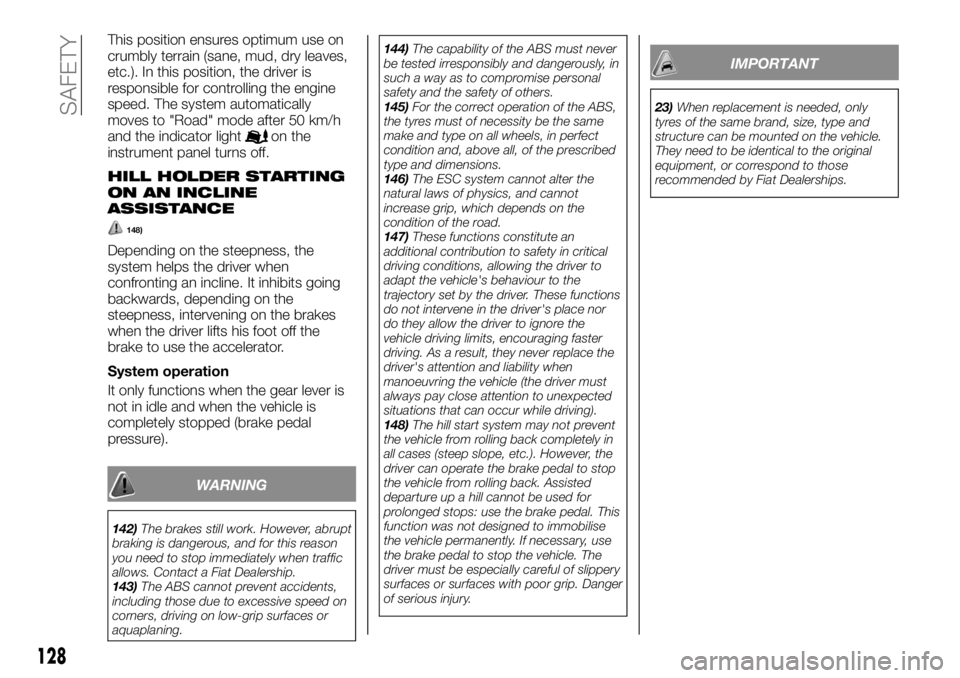
This position ensures optimum use on
crumbly terrain (sane, mud, dry leaves,
etc.). In this position, the driver is
responsible for controlling the engine
speed. The system automatically
moves to "Road" mode after 50 km/h
and the indicator light
on the
instrument panel turns off.
HILL HOLDER STARTING
ON AN INCLINE
ASSISTANCE
148)
Depending on the steepness, the
system helps the driver when
confronting an incline. It inhibits going
backwards, depending on the
steepness, intervening on the brakes
when the driver lifts his foot off the
brake to use the accelerator.
System operation
It only functions when the gear lever is
not in idle and when the vehicle is
completely stopped (brake pedal
pressure).
WARNING
142)The brakes still work. However, abrupt
braking is dangerous, and for this reason
you need to stop immediately when traffic
allows. Contact a Fiat Dealership.
143)The ABS cannot prevent accidents,
including those due to excessive speed on
corners, driving on low-grip surfaces or
aquaplaning.144)The capability of the ABS must never
be tested irresponsibly and dangerously, in
such a way as to compromise personal
safety and the safety of others.
145)For the correct operation of the ABS,
the tyres must of necessity be the same
make and type on all wheels, in perfect
condition and, above all, of the prescribed
type and dimensions.
146)The ESC system cannot alter the
natural laws of physics, and cannot
increase grip, which depends on the
condition of the road.
147)These functions constitute an
additional contribution to safety in critical
driving conditions, allowing the driver to
adapt the vehicle's behaviour to the
trajectory set by the driver. These functions
do not intervene in the driver's place nor
do they allow the driver to ignore the
vehicle driving limits, encouraging faster
driving. As a result, they never replace the
driver's attention and liability when
manoeuvring the vehicle (the driver must
always pay close attention to unexpected
situations that can occur while driving).
148)The hill start system may not prevent
the vehicle from rolling back completely in
all cases (steep slope, etc.). However, the
driver can operate the brake pedal to stop
the vehicle from rolling back. Assisted
departure up a hill cannot be used for
prolonged stops: use the brake pedal. This
function was not designed to immobilise
the vehicle permanently. If necessary, use
the brake pedal to stop the vehicle. The
driver must be especially careful of slippery
surfaces or surfaces with poor grip. Danger
of serious injury.
IMPORTANT
23)When replacement is needed, only
tyres of the same brand, size, type and
structure can be mounted on the vehicle.
They need to be identical to the original
equipment, or correspond to those
recommended by Fiat Dealerships.
128
SAFETY
Page 134 of 236
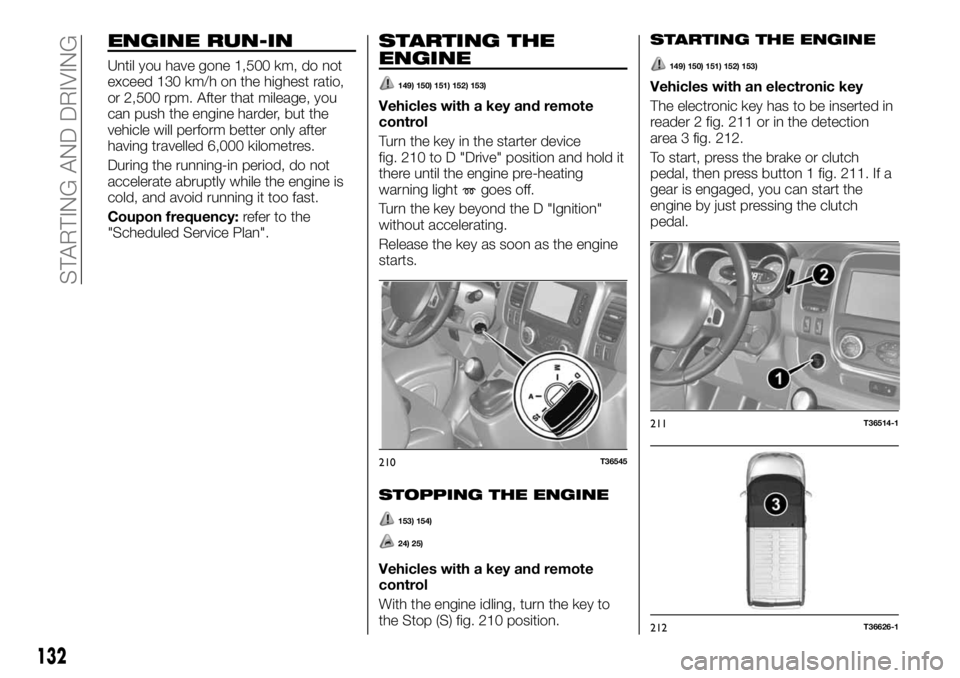
ENGINE RUN-IN
Until you have gone 1,500 km, do not
exceed 130 km/h on the highest ratio,
or 2,500 rpm. After that mileage, you
can push the engine harder, but the
vehicle will perform better only after
having travelled 6,000 kilometres.
During the running-in period, do not
accelerate abruptly while the engine is
cold, and avoid running it too fast.
Coupon frequency:refer to the
"Scheduled Service Plan".
STARTING THE
ENGINE
149) 150) 151) 152) 153)
Vehicles with a key and remote
control
Turn the key in the starter device
fig. 210 to D "Drive" position and hold it
there until the engine pre-heating
warning light
goes off.
Turn the key beyond the D "Ignition"
without accelerating.
Release the key as soon as the engine
starts.
STOPPING THE ENGINE
153) 154)
24) 25)
Vehicles with a key and remote
control
With the engine idling, turn the key to
the Stop (S) fig. 210 position.
STARTING THE ENGINE
149) 150) 151) 152) 153)
Vehicles with an electronic key
The electronic key has to be inserted in
reader 2 fig. 211 or in the detection
area 3 fig. 212.
To start, press the brake or clutch
pedal, then press button 1 fig. 211. If a
gear is engaged, you can start the
engine by just pressing the clutch
pedal.
210T36545
211T36514-1
212T36626-1
132
STARTING AND DRIVING
Page 136 of 236

USING THE
GEARBOX
155)
26)
To engage reverse (vehicle
stopped)
From the neutral position, lift up ring 1
fig. 213 against the lever knob to
engage reverse gear.
The reverse lights go on when the gear
is engaged (starter device in position
M).
WARNING
155)Depress the clutch pedal fully to
change gear correctly. It is therefore
essential that there is nothing under the
pedals: make sure the mats are lying flat
and do not get in the way of the pedals.
IMPORTANT
26)Do not drive with your hand resting on
the gear lever as the force exerted, even if
slight, could lead over time to premature
wear of the gearbox internal components.
PARKING THE
VEHICLE
156) 157)
27) 28) 29)
Proceed as follows when parking and
leaving the vehicle:
engage a gear (1st gear if facing
uphill or reverse if facing downhill) and
leave the wheels turned;
stop the engine and engage the
handbrake;
always remove the ignition key.
Block the wheels with a wedge or a
stone if the vehicle is parked on a steep
slope.
IMPORTANTNEVERleave the vehicle
with the gear in neutral.
HANDBRAKE
To engage the handbrake, pull the lever
up and check that the vehicle is
immobilised properly. The
warning
light will come on in the instrument
panel.
To release the handbrake, pull the lever
up slightly, press the button 2
fig. 214and accompany the lever down
to its rest position. The indicator light
turns off.
213T36534-1
134
STARTING AND DRIVING
Page 137 of 236
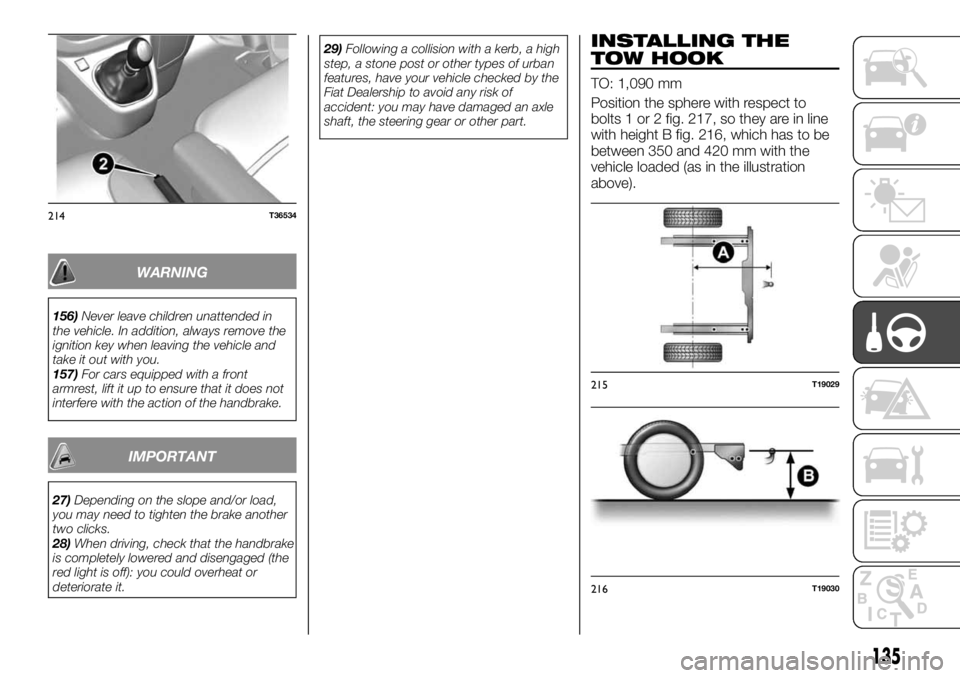
WARNING
156)Never leave children unattended in
the vehicle. In addition, always remove the
ignition key when leaving the vehicle and
take it out with you.
157)For cars equipped with a front
armrest, lift it up to ensure that it does not
interfere with the action of the handbrake.
IMPORTANT
27)Depending on the slope and/or load,
you may need to tighten the brake another
two clicks.
28)When driving, check that the handbrake
is completely lowered and disengaged (the
red light is off): you could overheat or
deteriorate it.29)Following a collision with a kerb, a high
step, a stone post or other types of urban
features, have your vehicle checked by the
Fiat Dealership to avoid any risk of
accident: you may have damaged an axle
shaft, the steering gear or other part.
INSTALLING THE
TOW HOOK
TO: 1,090 mm
Position the sphere with respect to
bolts 1 or 2 fig. 217, so they are in line
with height B fig. 216, which has to be
between 350 and 420 mm with the
vehicle loaded (as in the illustration
above).
214T36534
215T19029
216T19030
135
Page 142 of 236

A general grade from 0 to 100 appears
that allows you to assess your
ecological driving performance: high
values mean reduced fuel consumption.
Below is some ecological advice to
improve your performance. Store your
preferred routes lets you compare
performances. For further information,
refer to the RADIO/TOUCH – RADIO
NAV supplement.
ECOMODE
ECOMODE is a function that optimises
fuel consumption. It acts on a few of
the vehicle's uses (heating, air
conditioning, power steering, etc.) and
on a few driving operations
(acceleration, gear shift, speed
regulation, deceleration, etc.).
Activation of the function
Press button 4 fig. 225.
TheECOfig. 226 indicator light 5 on
the instrument panel turns on to
confirm that it has been activated.
While driving, you can temporarily leave
the ECOMODE function to reset all
engine performances.
To do this, press the accelerator pedal
firmly.
The ECOMODE function is reactivated
as soon as you release the accelerator.
Deactivating the function
Press button 4 fig. 225.
TheECOfig. 226 warning light 5 on the
instrument panel turns off to confirm
that it has been deactivated.BehaviourRather than heat the engine while
stopped, we advise you to drive
moderately until the engine reaches its
normal operating temperature.
Speed increases fuel consumption.
Do not strain the engine by
exceeding speed in intermediary gears.
Use the highest gear.
Avoid sudden acceleration.
Brake as little as possible. By
assessing the danger or curve in
advance, it will be sufficient to lift your
foot off the accelerator.
When going uphill, we advise you to
keep a steady speed, without having to
change it.
In modern vehicles, double clutching
before stopping the engine is not
necessary and could even cause
damage.Tyres fig. 227
Pressure too low can increase fuel
consumption.
Using unsuitable tyres can increase
fuel consumption.
Advice for use
Favour the ECOMODE function.
Electricity increases fuel
consumption. We advise you to turn off
accessories when they are not in use.
You must use your lights according to
the laws in effect in the country you are
in.
Use diffusers as much as possible.
Driving at 100 km/h with the windows
open increases fuel consumption by
4% fig. 228.
For vehicles with climate control, fuel
consumption is increased (especially in
cities) when in use. For vehicles with
manual climate control, turn off the
system when you no longer need it.
227T26528
228T31077
140
STARTING AND DRIVING
Page 148 of 236
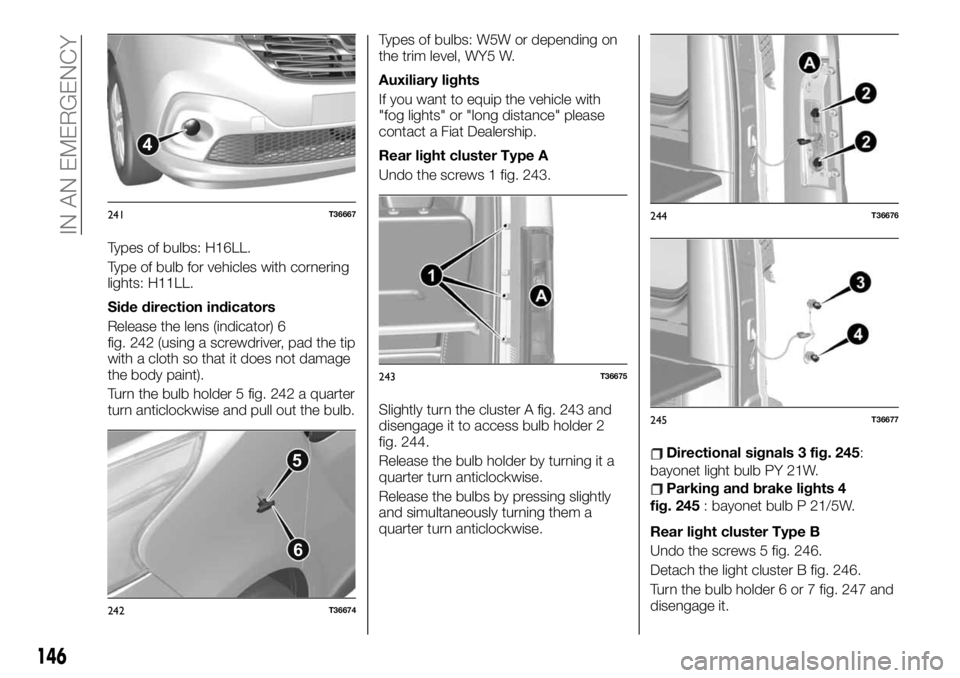
Types of bulbs: H16LL.
Type of bulb for vehicles with cornering
lights: H11LL.
Side direction indicators
Release the lens (indicator) 6
fig. 242 (using a screwdriver, pad the tip
with a cloth so that it does not damage
the body paint).
Turn the bulb holder 5 fig. 242 a quarter
turn anticlockwise and pull out the bulb.Types of bulbs: W5W or depending on
the trim level, WY5 W.
Auxiliary lights
If you want to equip the vehicle with
"fog lights" or "long distance" please
contact a Fiat Dealership.
Rear light cluster Type A
Undo the screws 1 fig. 243.
Slightly turn the cluster A fig. 243 and
disengage it to access bulb holder 2
fig. 244.
Release the bulb holder by turning it a
quarter turn anticlockwise.
Release the bulbs by pressing slightly
and simultaneously turning them a
quarter turn anticlockwise.
Directional signals 3 fig. 245:
bayonet light bulb PY 21W.
Parking and brake lights 4
fig. 245: bayonet bulb P 21/5W.
Rear light cluster Type B
Undo the screws 5 fig. 246.
Detach the light cluster B fig. 246.
Turn the bulb holder 6 or 7 fig. 247 and
disengage it.
4
241T36667
5
6
242T36674
243T36675
244T36676
245T36677
146
IN AN EMERGENCY
Page 149 of 236
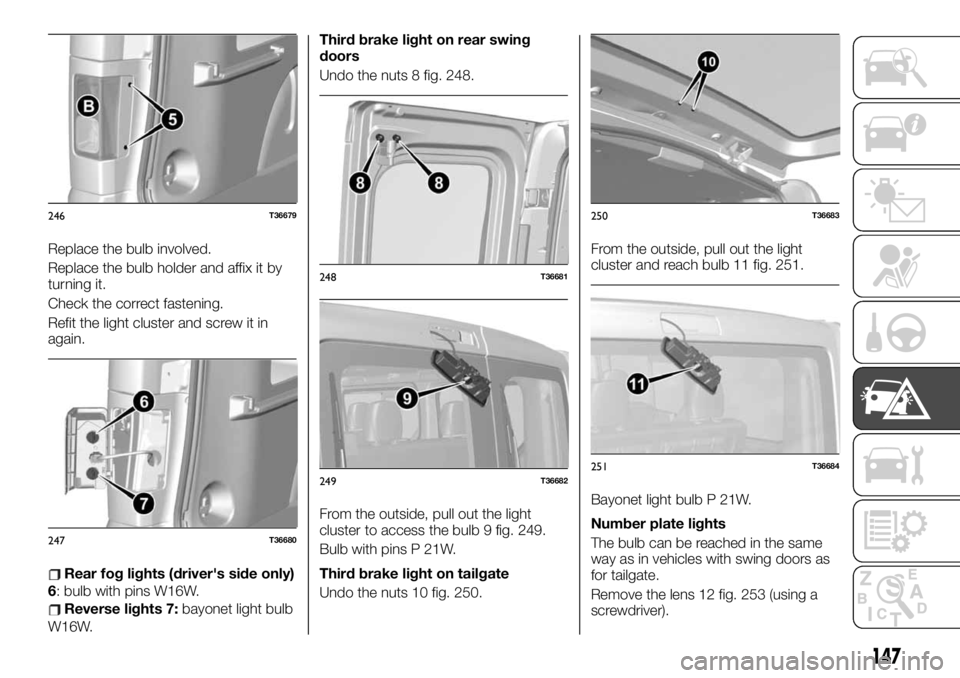
Replace the bulb involved.
Replace the bulb holder and affix it by
turning it.
Check the correct fastening.
Refit the light cluster and screw it in
again.
Rear fog lights (driver's side only)
6: bulb with pins W16W.
Reverse lights 7:bayonet light bulb
W16W.Third brake light on rear swing
doors
Undo the nuts 8 fig. 248.
From the outside, pull out the light
cluster to access the bulb 9 fig. 249.
Bulb with pins P 21W.
Third brake light on tailgate
Undo the nuts 10 fig. 250.From the outside, pull out the light
cluster and reach bulb 11 fig. 251.
Bayonet light bulb P 21W.
Number plate lights
The bulb can be reached in the same
way as in vehicles with swing doors as
for tailgate.
Remove the lens 12 fig. 253 (using a
screwdriver).
246T36679
247T36680
248T36681
249T36682
250T36683
251T36684
147
Page 154 of 236
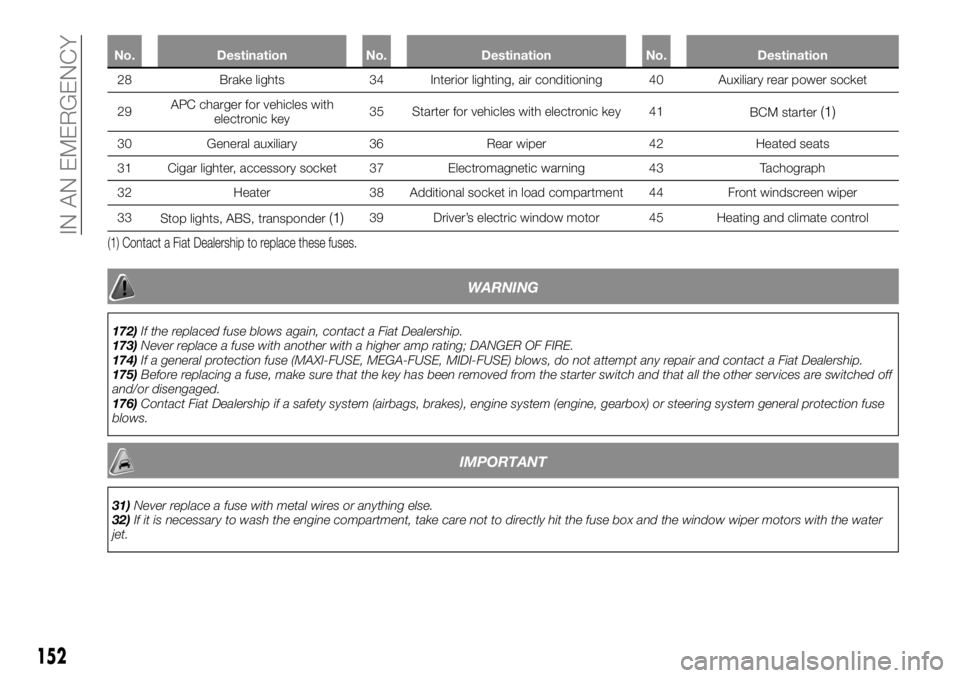
No. Destination No. Destination No. Destination
28 Brake lights 34 Interior lighting, air conditioning 40 Auxiliary rear power socket
29APCcharger for
vehicles with
electronic key35 Starter for vehicles with electronic key 41
BCM starter
(1)
30 General auxiliary 36 Rear wiper 42 Heated seats
31 Cigar lighter, accessory socket 37 Electromagnetic warning 43 Tachograph
32 Heater 38 Additional socket in load compartment 44 Front windscreen wiper
33
Stop lights, ABS, transponder
(1)39 Driver’s electric window motor 45 Heating and climate control
(1) Contact a Fiat Dealership to replace these fuses.
WARNING
172)If the replaced fuse blows again, contact a Fiat Dealership.
173)Never replace a fuse with another with a higher amp rating; DANGER OF FIRE.
174)If a general protection fuse (MAXI-FUSE, MEGA-FUSE, MIDI-FUSE) blows, do not attempt any repair and contact a Fiat Dealership.
175)Before replacing a fuse, make sure that the key has been removed from the starter switch and that all the other services are switched off
and/or disengaged.
176)Contact Fiat Dealership if a safety system (airbags, brakes), engine system (engine, gearbox) or steering system general protection fuse
blows.
IMPORTANT
31)Never replace a fuse with metal wires or anything else.
32)If it is necessary to wash the engine compartment, take care not to directly hit the fuse box and the window wiper motors with the water
jet.
152
IN AN EMERGENCY
Page 157 of 236
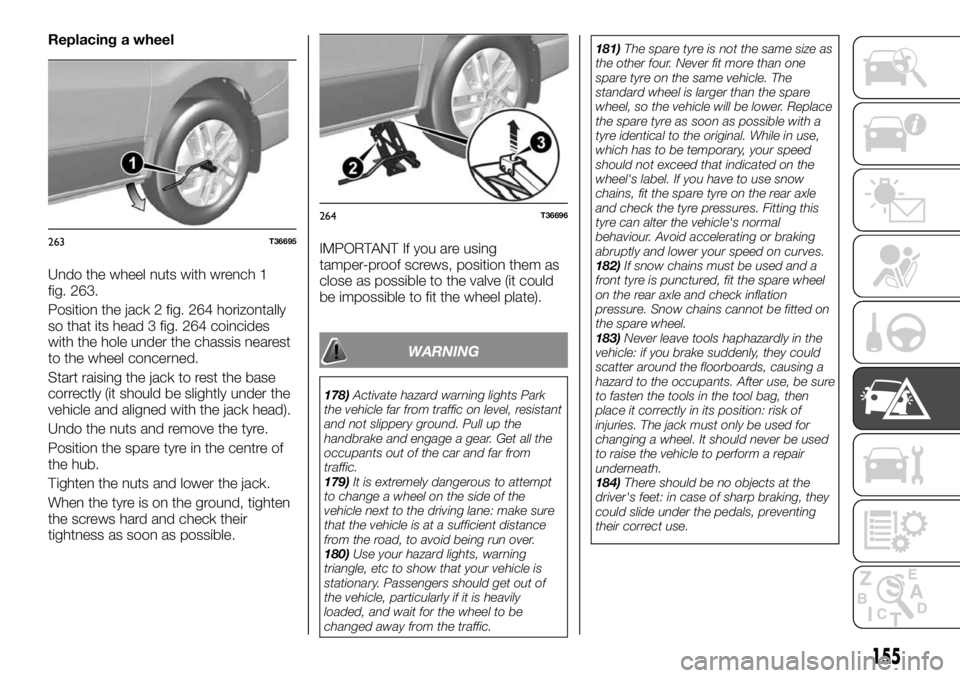
Replacing a wheel
Undo the wheel nuts with wrench 1
fig. 263.
Position the jack 2 fig. 264 horizontally
so that its head 3 fig. 264 coincides
with the hole under the chassis nearest
to the wheel concerned.
Start raising the jack to rest the base
correctly (it should be slightly under the
vehicle and aligned with the jack head).
Undo the nuts and remove the tyre.
Position the spare tyre in the centre of
the hub.
Tighten the nuts and lower the jack.
When the tyre is on the ground, tighten
the screws hard and check their
tightness as soon as possible.IMPORTANT If you are using
tamper-proof screws, position them as
close as possible to the valve (it could
be impossible to fit the wheel plate).
WARNING
178)Activate hazard warning lights Park
the vehicle far from traffic on level, resistant
and not slippery ground. Pull up the
handbrake and engage a gear. Get all the
occupants out of the car and far from
traffic.
179)It is extremely dangerous to attempt
to change a wheel on the side of the
vehicle next to the driving lane: make sure
that the vehicle is at a sufficient distance
from the road, to avoid being run over.
180)Use your hazard lights, warning
triangle, etc to show that your vehicle is
stationary. Passengers should get out of
the vehicle, particularly if it is heavily
loaded, and wait for the wheel to be
changed away from the traffic.181)The spare tyre is not the same size as
the other four. Never fit more than one
spare tyre on the same vehicle. The
standard wheel is larger than the spare
wheel, so the vehicle will be lower. Replace
the spare tyre as soon as possible with a
tyre identical to the original. While in use,
which has to be temporary, your speed
should not exceed that indicated on the
wheel's label. If you have to use snow
chains, fit the spare tyre on the rear axle
and check the tyre pressures. Fitting this
tyre can alter the vehicle's normal
behaviour. Avoid accelerating or braking
abruptly and lower your speed on curves.
182)If snow chains must be used and a
front tyre is punctured, fit the spare wheel
on the rear axle and check inflation
pressure. Snow chains cannot be fitted on
the spare wheel.
183)Never leave tools haphazardly in the
vehicle: if you brake suddenly, they could
scatter around the floorboards, causing a
hazard to the occupants. After use, be sure
to fasten the tools in the tool bag, then
place it correctly in its position: risk of
injuries. The jack must only be used for
changing a wheel. It should never be used
to raise the vehicle to perform a repair
underneath.
184)There should be no objects at the
driver's feet: in case of sharp braking, they
could slide under the pedals, preventing
their correct use.
263T36695
264T36696
155
Page 159 of 236
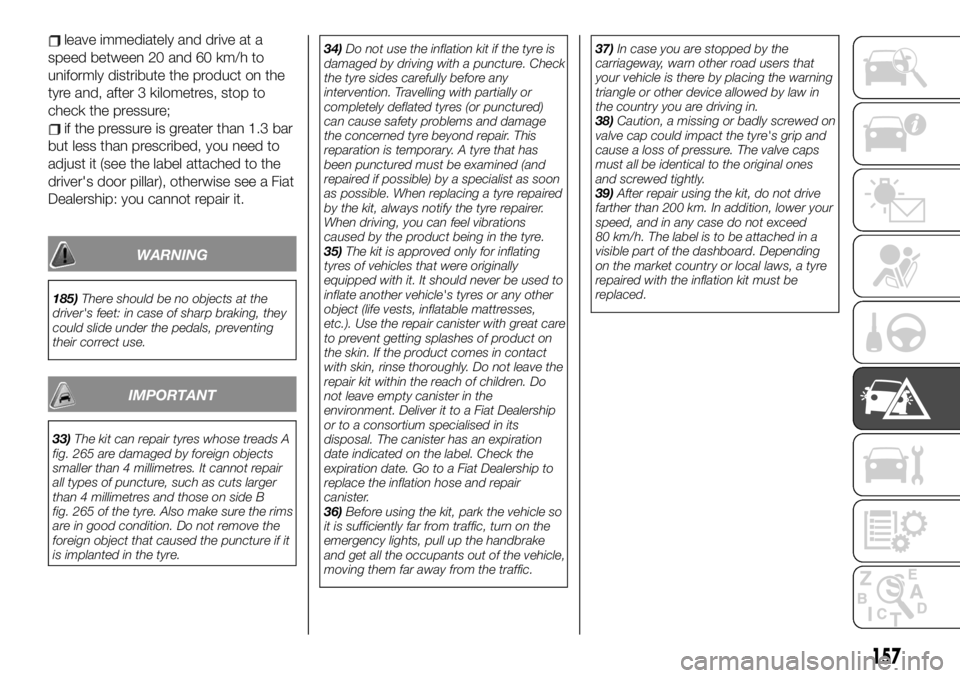
leave immediately and drive at a
speed between 20 and 60 km/h to
uniformly distribute the product on the
tyre and, after 3 kilometres, stop to
check the pressure;
if the pressure is greater than 1.3 bar
but less than prescribed, you need to
adjust it (see the label attached to the
driver's door pillar), otherwise see a Fiat
Dealership: you cannot repair it.
WARNING
185)There should be no objects at the
driver's feet: in case of sharp braking, they
could slide under the pedals, preventing
their correct use.
IMPORTANT
33)The kit can repair tyres whose treads A
fig. 265 are damaged by foreign objects
smaller than 4 millimetres. It cannot repair
all types of puncture, such as cuts larger
than 4 millimetres and those on side B
fig. 265 of the tyre. Also make sure the rims
are in good condition. Do not remove the
foreign object that caused the puncture if it
is implanted in the tyre.34)Do not use the inflation kit if the tyre is
damaged by driving with a puncture. Check
the tyre sides carefully before any
intervention. Travelling with partially or
completely deflated tyres (or punctured)
can cause safety problems and damage
the concerned tyre beyond repair. This
reparation is temporary. A tyre that has
been punctured must be examined (and
repaired if possible) by a specialist as soon
as possible. When replacing a tyre repaired
by the kit, always notify the tyre repairer.
When driving, you can feel vibrations
caused by the product being in the tyre.
35)The kit is approved only for inflating
tyres of vehicles that were originally
equipped with it. It should never be used to
inflate another vehicle's tyres or any other
object (life vests, inflatable mattresses,
etc.). Use the repair canister with great care
to prevent getting splashes of product on
the skin. If the product comes in contact
with skin, rinse thoroughly. Do not leave the
repair kit within the reach of children. Do
not leave empty canister in the
environment. Deliver it to a Fiat Dealership
or to a consortium specialised in its
disposal. The canister has an expiration
date indicated on the label. Check the
expiration date. Go to a Fiat Dealership to
replace the inflation hose and repair
canister.
36)Before using the kit, park the vehicle so
it is sufficiently far from traffic, turn on the
emergency lights, pull up the handbrake
and get all the occupants out of the vehicle,
moving them far away from the traffic.37)In case you are stopped by the
carriageway, warn other road users that
your vehicle is there by placing the warning
triangle or other device allowed by law in
the country you are driving in.
38)Caution, a missing or badly screwed on
valve cap could impact the tyre's grip and
cause a loss of pressure. The valve caps
must all be identical to the original ones
and screwed tightly.
39)After repair using the kit, do not drive
farther than 200 km. In addition, lower your
speed, and in any case do not exceed
80 km/h. The label is to be attached in a
visible part of the dashboard. Depending
on the market country or local laws, a tyre
repaired with the inflation kit must be
replaced.
157